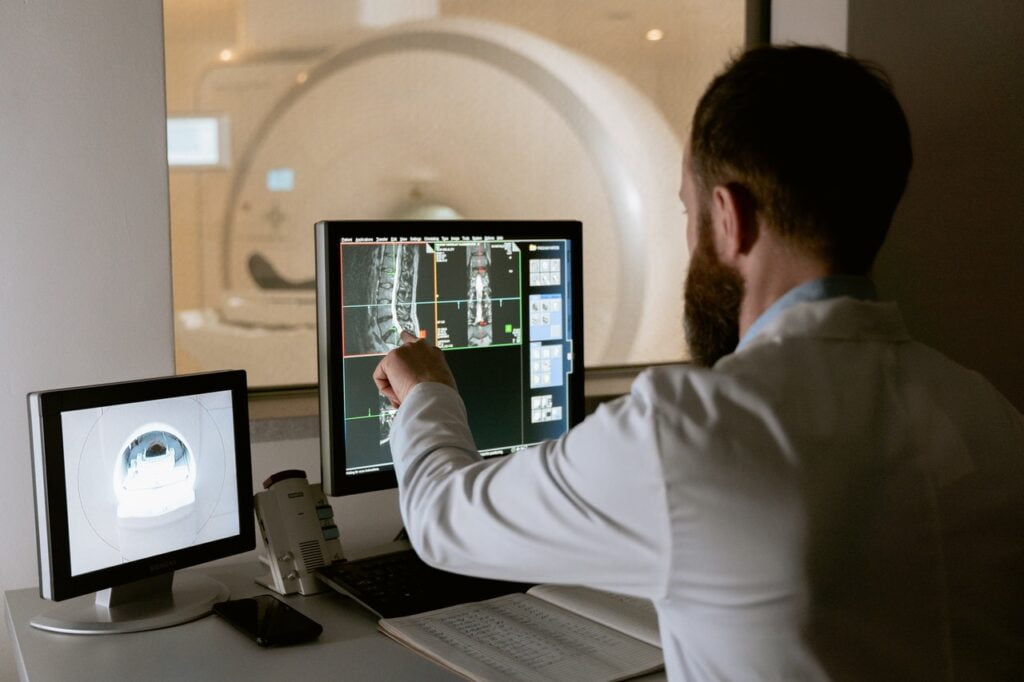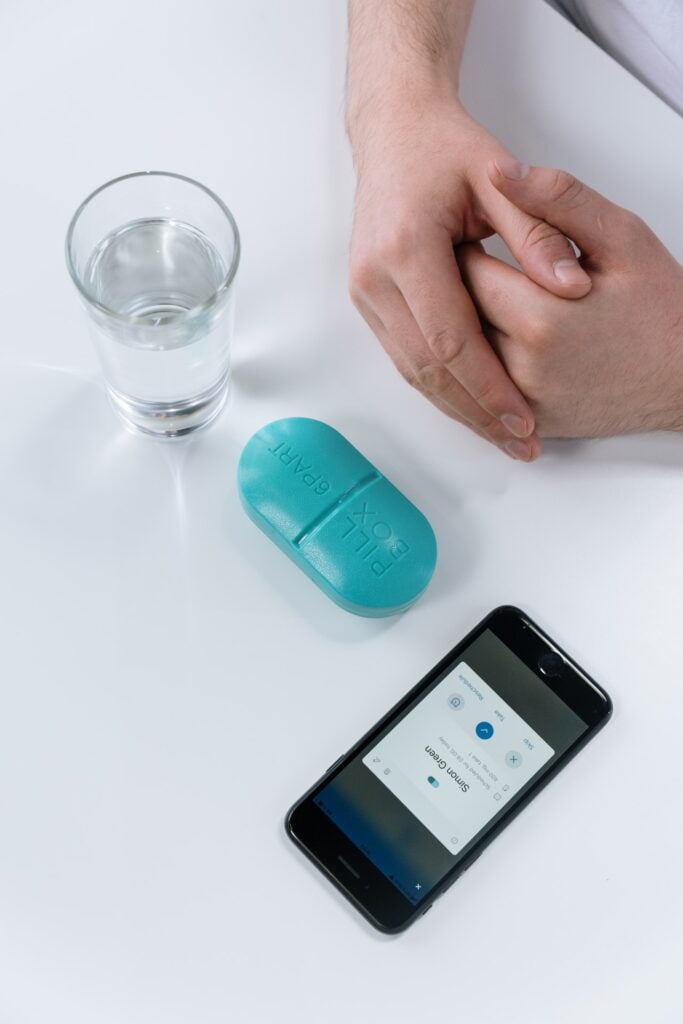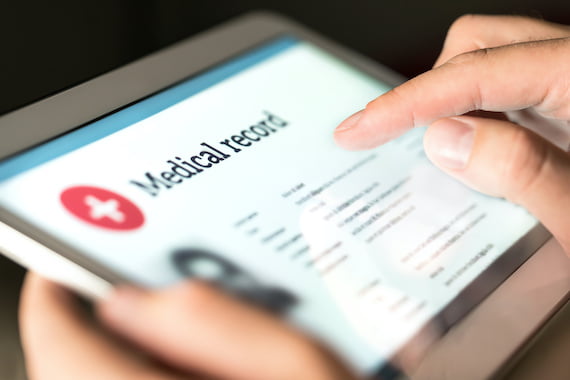Mental health and the use of technology
Dive into the newest mental health tech trends and find more about avant-garde products

Financial services
Expertise in core banking, BaaS integrations, payments, and GenAI-enhanced financial solutions.

Healthcare
People-centric healthcare design and solutions, from virtual care, integrations, to smart devices.

Insurance
Modern solutions including self-service, on-demand, and algorithm-driven personalization.

We’re purposefully shaping the digital future across a range of industries.
Discover some of our specific industry services.
Discover moreMarch 20, 2023
Learn how the latest trends are leading the evolution of Digital technology in healthcare

Few industries have experienced the level of disruption felt by the digital transformation of the healthcare system. It wasn’t long ago the phrase “digital health” didn’t exist. Yet today, providing digital health solutions is not only a standard service, it’s a market differentiator.
Health tech startups are continually emerging and healthcare companies often team up with technology innovators to deliver innovative solutions before their competition.
The scope of digital health services is vast, including both patient-facing technologies and services for healthcare professionals such as physicians, researchers, facility administrators, and more. Far from a COVID-19 pandemic trend, healthcare tech is just getting started. By the end of this article, you’ll understand what we mean when talking about Digital Health, its scope, importance and some of the popular digital tools and technology trends today.
Before deep-diving into the relevance that Digital Health has in today’s society, let’s begin by defining what we mean when we talk about this broad concept.
When defining Digital Health or Digital Healthcare, we have to bear in mind that this discipline includes a multidisciplinary set of ideas, notions and concepts in the intersection recently formed between technology and healthcare. Digital Health is the application and implementation of the digital transformation strategy in the healthcare field, which entails incorporating both software & hardware solutions and services to facilitate different needs. In short words, the latter means using technology (its methods, processes, tools and devices) to improve the general well-being of people/patients, while also providing them with tools to be more conscious, know themselves on a deeper level and make better-informed decisions about their health.
By making use of platforms, connectivity software and sensors for healthcare-related usage, Digital Health technologies cover a wide range of uses in different sectors: from apps that alleviate mental health issues, and general wellness to those that actually operate as medical devices. This discipline also includes applications intended to be used as a medical product, in a medical product, even those that act as companion diagnostics or as an adjunct to other medical products (biologics, devices, or drugs, among others). Lastly, another relevant usage of Digital Health apps has to do with scientific research: those implemented in the development or study of medical products. Here’s where the complexity of Digital Health lies: not only there is a great variety of uses for all these different tools, but there are also a lot of disciplines, tools, platforms, software and even target users that employ these services on a daily basis.
According to the FDA, the umbrella term Digital Health includes categories such as mobile health (mHealth) apps, electronic medical records (EMRs), electronic health records (EHRs), personalized medicine solutions, telehealth, telemedicine as well as wearable devices.
But, who are the main stakeholders and target audiences for all these innovative applications, categories and solutions? As well as the concept of Digital Health, this group is conformed by a heterogeneous mix that includes patients, practitioners, software developers, distributors, medical device manufacturers and researchers who all work to deliver innovative solutions.
The technology advancements that took place in the IT industry also naturally spilled over and benefited other sectors and industries such as healthcare. As time progressed and both hardware and software tools became more user-friendly, patients and healthcare institutions began to implement these technologies as a way to gather more control over their patient’s data and provide better services. Nowadays, the widespread use of Digital Health tools and platforms allows patients to track their health and vitals in ways they could never imagine, letting them have a deeper understanding of their vitals, and therefore, of their health. We will now aim to explain some key milestones that granted the massive transformation of healthcare services and evolved into what we now know as Digital Health.
According to authors Margaret Ann Cary and Adam Darkins in their book Telemedicine and Telehealth: Principles, Policies, Performance and Pitfalls, the first documented telemedicine-related occurrence took place in 1897 when a child was diagnosed with a viral respiratory infection during a telephone consultation with a physician. This was such an innovative incident not only because phones were recently invented and there was no such thing as universal accessibility to them, but also, especially because long-distance diagnosis was a revolutionary practice since it was reserved for Antarctica expeditions and, later on, for space missions. This milestone slowly started revolutionizing the conventional approach physicians had to engage with patients.
Technological advancements such as the development of more refined ultrasound imaging technologies, the possibility of using artificial organs for transplants and DNA sequencing increased the involvement of technology in medicine. These inventions not only paved the way but also proved that the degree to which digital technology could be used in medicine was increasing exponentially. From the implementation of simple telemedicine solutions during the early days of the XIX and mid-XX centuries, in this new era, Digital Health acquired new forms and went past the previously established boundaries of only diagnosing patients to now providing more complex treatments and engaging a diversified catalog of procedures.

In the middle of what we are defining as ‘The 90’s Boom’, we were direct witnesses of the golden era of Digital Health. Taking place between the end of the 80s and the beginning of the 1990s, these digital health tech advances allowed for the emergence of several professional associations in the US and around the world that had the aim of improving healthcare by implementing digital communication. Their more than positive impact allowed for the further development of technology and the detour away from traditional healthcare techniques to advanced procedures. Among these organizations, examples include the International Medical Informatics Association, American Telemedicine Association, and the European Health Telematics Association (EHTEL).
This period was not only brought by the new century but it also came with an increase in physicians, patients, and users’ overall demand for going a step further in the process of digitizing healthcare and creating more solutions that fit their needs. With even more advancements such as the Internet, the World Wide Web (and even more access to it as we approach the 2010s to mid-2010’s), more gadgets and devices appeared, all thanks to the technologies and resources poured into researching and developing high-tech digital experiences that intertwined with telehealth and telemedicine processes. An important aspect to highlight also had to do with how concepts such as user experience and usability came to the forefront when referring to developing software solutions. Whether Web or Mobile focused, these technological innovations allowed patients to gain easier access to the world of medicine. These solutions are what we now refer to as Personalized Health: mHealth (Mobile Health) or eHealth (Electronic Health).

As well as the development of more advanced software technologies, the decade 2010 also witnessed the birth of digital therapeutics. According to the European Data Protection Supervisor (EDPS), Digital Therapeutics (DTx) are evidence-based therapies and therapeutic interventions that, by using mobile and virtual reality devices, apps, sensors, the Internet of Things, and other software and hardware tools, help observe behavioral changes in patients and prevent, manage or treat a medical disease or disorder. Their proven clinical benefits are endless: from supporting patients in self-managing their symptoms to overall improving their quality of life, Digital Therapeutics provides customized health services, mainly since their design is tailored to fit the specific needs of an individual user.
With Digital Therapeutics, a new wave of wellness and health-oriented aficionados emerged. Thanks to the hugely commercialized success that Wearable devices -one of the many categories of both therapeutic and non-therapeutic devices under the umbrella term that is DTx- turned out to be, millions of users rapidly indulged in buying these products, creating, again, another powerful shift on this market. From this point on, Digital Health was no longer an expensive branch of treatment but rather was in the hands of all types of users, who were in control of their data and could easily track all their vitals and be fully aware of their medical conditions.
During the last decade (from 2010 to 2020) digital technology in healthcare has grown into its unique market. Nowadays, this discipline is more than considered to be an accepted path for those patients and institutions willing to achieve higher standards of health, while enriching the pool of data available on multiple conditions, diseases and pathologies.
During this last decade, but especially in 2017, 2018 and 2020 three major milestones or events helped escalate even more the development of digital technology in healthcare.
The first milestone had to do with the launch of the Digital Health Unit by the US Food and Drug Administration (FDA) in 2017. The units’ goal is to allow for potential expansion opportunities for the sector and turn them into general benefits for the healthcare industry, as well as regulate a variety of technologies implemented in Digital Health. The Digital Health Unit also works towards the development of new frameworks and the approval of new systems, alongside collecting data and post-market experience as a way to keep up with all the advancements and how they could be translated into new technologies. Thanks to their processes, their work has considerably improved the development and distribution of Digital Health technologies.

The second relevant milestone took place in 2018 when the American Medical Association (AMA) -which, since its establishment in 1847, has been playing a key role in the development of healthcare in the US- published its AI policy. The document finally acknowledged the relevance that AI posed to Digital Healthcare and introduced several recommendations on its use. Among its objectives, the AMA actively involved the Department of Healthcare in AI-related topics, encouraging education in technology (especially in AI) for physicians and patients as well as aimed for the growth of care, enhancing physician and people’s satisfaction while improving their health. Alongside these contributions, the AMA also highlighted the limitations of AI while acknowledging that the emerging technologies and solutions proposed in this industry were becoming more and more sophisticated and user-friendly. In the years to come, the AMA Policy continued to be updated and created new ethical, privacy and regulatory issues that will, later on, need to be addressed.
The last but not least milestone of the Digital Health era we are currently living in was in 2020 with the development of a first-of-a-kind AI-guided ultrasound device approved by the FDA. With the goal in mind to further innovate in this market and create a new regulatory body and classification system, the FDA allowed for future creation of similar types of devices to quickly reach the market, granted that they follow the same intended use. Direct effects of approving the AI-guided ultrasound technology not only had to do with allowing an innovation flow to occur in the market but also providing more companies the opportunity to change today’s reality. Despite only being available in hospital facilities, for the time being, AI-guided ultrasound technology is intended for physicians, but it could also be used by untrained staff in assisting professionals during the process of image taking of organs such as heart, lungs, etc.
All these digital health tech advancements, new regulations and policies only denote one thing: Digital Health as an industry and discipline is a reality that is here to stay. Numbers point to it too: in 2021, Digital Health companies that carried out strong Research and Development (R&D) activities in sectors such as BioPharma and MedTech brought in a record investment of $5.8 billion in funding. Stimulated by the COVID-accelerated world of real data and new medical devices that allow for the tracking of different vitals, investments in digital products supporting several disease treatments grew approximately 2.6% between 2020 and 2021, according to Rock Health’s year-end Digital Health Stats. In addition, healthcare marketplaces also appointed a 3% year-over-year funding growth.
In other words, the expansion of Digital Health is becoming apparent to the general public. The introduction of digital technology in healthcare has more than a promising future: as technology keeps progressing, this industry will continue to create new ways to deliver the best-next-alternatives to patient care, from software solutions, specialized devices to wearables accessible to all public, this discipline is strongly developing into a standalone market that aims to improve the general well being of the population while providing more responsive, proactive and sustainable ways of delivering Digital Health.

Digital Health is rapidly creating a tech ecosystem that offers patients -and physicians- the ability to better manage and monitor their conditions. From the essential and most basic services such as telemedicine to certain specialized devices and even software tools that allow them to practice what is known as ‘lifestyle medicine’, this is the most important value that Digital Health technology holds for users worldwide. We will now highlight the most common benefits of implementing Digital Health tools, procedures, or processes.
While it’s a simple and common form of digital health, telemedicine is vitally important for some consumers. When searching for a doctor or medical office, patients now actively seek providers that offer at least basic digital services.
Digital health offers improved solutions for effective treatment, digitized health records, and a more efficient patient-provider ecosystem.
For many people living in rural areas or low economic neighborhoods, seeing a health professional means lengthy travel or a ride on public transportation when they’re not feeling well. Some may not be able to go at all, risking worsening health or further aggravating a chronic condition. As well as reducing distances, Digital Health apps and devices can reduce and even cut certain provider costs. Technology can also reduce the number of emergency visits, doctor’s appointments, and hospital admissions.
For the elderly or those with pre-existing conditions, a virtual office visit allows those patients to stay isolated, protecting themselves and anyone they come in contact with during an office visit.
Lastly, another advantage of implementing Digital Health technology, techniques and processes have to do with the creation of a great data repository on the many health markers of users worldwide, all thanks to the different devices that track users’ biometrics. In combination with AI and Big Data, this substantial amount of data could later on be used to connect the dots between people’s lifestyles and different conditions, while figuring out how different variables interact with each other, thus concluding if different choices decrease or increase the possibility of developing certain medical conditions.

Leaping the basics, digital health service innovations monitor issues like heart disease, persistent pain, chronic conditions, and even breast health and fertility. These treatments use wearable, implantable, or ingestible devices that provide digital health companies with real-time data through wireless technologies.
To help you grasp the scope of health tech devices and emerging technologies used in digital healthcare services, consider these areas:
When it comes to patient care, these digital health technologies and devices give insight into more patient data, leading to better and faster diagnoses. For example, instead of measuring a heart rate once a month at a scheduled appointment, a medical device can transmit that data every hour, 24 hours a day. Specialists can monitor the data between in-person appointments and get a more holistic view of the patient’s condition rather than a point-in-time glimpse into their condition.

With EHR’s (electronic health records), patients no longer need to request their medical records, pick them up, and distribute them to each of their specialists. The interoperability of digital health records makes it easy to share data between physicians, offices, and hospitals as patients grant access.
And while the personally identifiable information in a patient’s digital health record follows strict cybersecurity protocols and functions in compliance with HIPAA regulatory standards, health information about symptoms, conditions, and diseases can be gathered and stored in a global database for researchers’ analysis and study.
By creating a single repository of health data collected from all over the world, researchers could use machine learning and artificial intelligence on a global world scale to discover new ways to identify pre-disease indicators, achieve earlier diagnoses, and develop more effective treatments.
The vast amount of data contributing to these studies could greatly increase the possibility of identifying trends or patterns that would go unnoticed with fewer data. A patient’s private information stays private, yet they receive the collective public health benefit of group analysis and diagnostics.

Digital health tech is vital for both patients and healthcare providers. They’re so critical to the healthcare industry that the Food and Drug Administration (FDA) has created a Digital Health Center of Excellence “to advance healthcare by fostering responsible and high-quality digital health innovation.”
Digital healthcare services reduce healthcare inefficiencies and offer a more convenient and accessible way for patients and doctors to communicate.
Using a tech partner with knowledge and experience in digital health is critical to:
Qubika offers extensive experience in the critical areas of digital health and healthcare technology. As an expert in healthcare and wellness technology, we understand what it takes to deliver digital health tech in this unique vertical. Whether you’re just getting started on your digital transformation or need technical resources to take your digital health solutions to the next level, our experienced team is ready to guide you. Email us today!

VP Client Strategy
Receive regular updates about our latest work
Dive into the newest mental health tech trends and find more about avant-garde products

Join us in discovering wearable medical technology and groundbreaking devices.

Check out our curated list of the most important summits for 2024 in the Digital Health industry.

Receive regular updates about our latest work
Get in touch with our experts to review your idea or product, and discuss options for the best approach
Get in touch